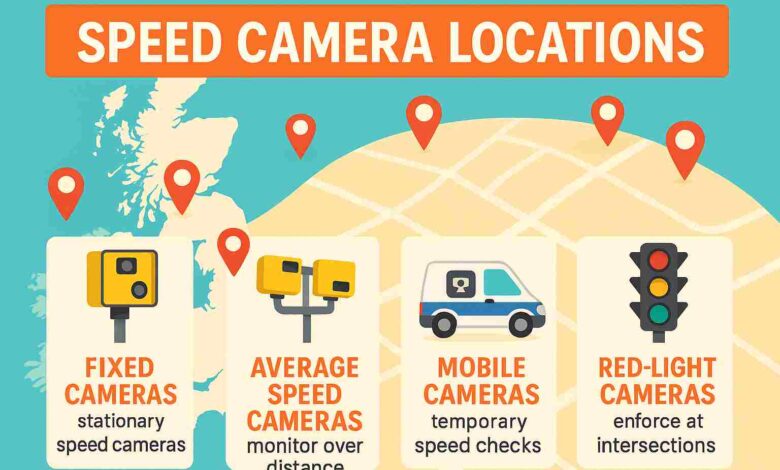Speed Camera Locations: The Ultimate Guide to Safer Roads in the UK
Understanding Speed Cameras, Their Types, and Why They Matter for Road Safety

Table of Contents
ToggleIntroduction
Speed cameras are a vital part of modern road safety, helping to prevent accidents, save lives, and enforce speed limits. In the UK, speed camera locations are carefully chosen based on accident history, traffic flow, and risk factors. Whether you are a driver trying to avoid fines or a road safety advocate looking to understand how these systems work, knowing about fixed speed camera lists, mobile speed camera schedules, and average speed camera locations can help you stay safe and compliant.
This guide provides a comprehensive overview of speed cameras, including their types, deployment strategies, and their role in reducing accidents. By the end, you will have a complete understanding of UK speed camera locations, the technology behind them, and why they are critical for safer roads.
Understanding Speed Camera Locations
Speed cameras are placed strategically at safety camera deployment areas to monitor speeding vehicles. These locations are chosen based on crash risk and camera placement studies, which analyze accident data and traffic behavior.
Many traffic enforcement camera maps are updated regularly, providing the GPS points of speed cameras and allowing drivers to identify speed camera hotspots. These tools help educate drivers and reduce reckless driving in high-risk areas.
Types of Speed Cameras in the UK
Fixed Speed Cameras
Fixed cameras are permanent installations often found in urban speed camera deployment zones and motorway speed camera locations.
-
Common types include Gatso camera locations and Truvelo camera points, designed to capture speeding vehicles instantly.
-
These are usually accompanied by roadside speed camera warning signs to inform drivers before reaching the enforcement area.
Mobile Speed Cameras
Mobile units, such as camera vans deployment times, are used in areas where fixed cameras are not practical.
-
These are frequently seen near schools (school zone speed enforcement cameras) or rural areas (rural road speed cameras).
-
They allow flexibility for police speed enforcement cameras to cover multiple regions on a mobile speed camera schedule.
Average Speed Cameras
Average speed cameras, such as SPECS camera zones, monitor speed over a stretch of road rather than at a single point.
-
Commonly used on motorways and construction zones, they prevent drivers from slowing down only near a fixed camera.
Red-Light and Combo Cameras
Some devices combine red-light camera positions and speed enforcement, improving road safety at intersections.
-
These systems are especially useful in congestion zone speed cameras and busy urban centers.
How Speed Cameras Work
Speed cameras operate using radar, laser, or camera technology radar vs lidar systems.
-
Radar-based devices track vehicle speed instantly, while LIDAR offers pinpoint accuracy.
-
Cameras equipped with ANPR average speed sections capture number plates for accurate identification and enforcement.
This data is stored in a speed camera database UK, ensuring transparency and accountability in law enforcement.
Deployment Strategies and Guidelines
Choosing the Right Locations
Authorities follow strict guidelines for camera placement, considering factors such as:
-
Accident history and risk value road segments for camera sites.
-
Local traffic volume and school residential zone enforcement criteria.
-
Visibility and compliance with speed camera signage regulations.
Regional Deployment
-
Safety camera partnerships regions work with councils and police to ensure fair deployment.
-
Maps like map of cameras by county and London speed camera locations provide public access to current camera positions.
Benefits of Speed Cameras
Reducing Collisions and Fatalities
Studies show that speed cameras significantly lower accident rates.
-
By enforcing speed limits, they reduce reckless driving and improve safety for pedestrians and drivers.
-
Speed camera collision data supports their effectiveness in saving lives.
Encouraging Responsible Driving
Public awareness campaigns and speed camera awareness campaigns encourage drivers to stay mindful of their speed.
-
Visible cameras act as deterrents, reducing violations without constant penalties.
Challenges and Public Perception
While cameras improve safety, some drivers see them negatively, viewing them as tools for generating revenue rather than preventing accidents.
-
Public information speed cameras and transparency reports help counter these concerns.
-
FOI requests speed camera data allow citizens to see where funds from fines are allocated.
Speed Camera Technology Upgrades
Modern systems are evolving rapidly with digital enforcement camera systems and automated speed enforcement technology.
-
Smart motorway speed cameras now monitor traffic dynamically, adjusting to conditions.
-
Replacement programs ensure outdated devices are swapped for more accurate and efficient models.
Quick Fact of Speed Camera Types
| Camera Type | Primary Use | Common Location |
|---|---|---|
| Fixed Cameras | Permanent speed monitoring | Urban areas, high-risk roads |
| Mobile Cameras | Flexible, temporary enforcement | Schools, rural areas |
| Average Speed Cameras | Monitor speed over distance | Motorways, construction zones |
| Red-Light Combo Cameras | Speed + red-light violations | Busy intersections, city roads |
Conclusion
Speed cameras play a crucial role in keeping UK roads safe. Understanding speed camera locations, their types, and how they work empowers drivers to stay informed and cautious. From fixed speed camera lists to mobile speed camera schedules, every enforcement strategy aims to save lives and reduce accidents.
While debates about fairness and revenue continue, there is no denying that speed cameras have a positive impact when deployed transparently and strategically. Drivers should use speed camera map apps UK and public resources to stay aware and drive responsibly.
Frequently Asked Questions (FAQ)
Q1. How do authorities decide where to place speed cameras?
Authorities analyze accident history, traffic flow, and community concerns, following strict guidelines for camera placement to target high-risk areas.
Q2. Are speed cameras always visible to drivers?
Yes, most fixed cameras must have clear roadside speed camera warning signs, but mobile units may not always be as visible.
Q3. What is the difference between fixed and mobile speed cameras?
Fixed cameras are permanent installations, while mobile cameras are temporary and can be moved across different regions based on camera vans deployment times.
Q4. Do speed cameras reduce accidents?
Absolutely. Data from speed camera collision data shows a significant drop in accidents and fatalities in areas with active enforcement.
Q5. How can drivers find speed camera locations?
Drivers can check traffic enforcement camera maps, speed camera GPS databases, or official map of cameras by county for accurate updates.



